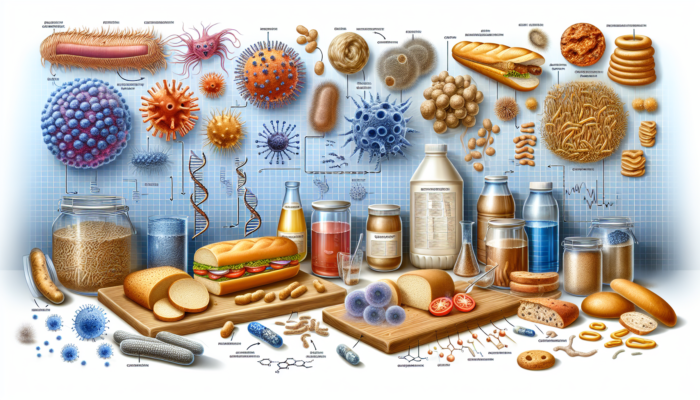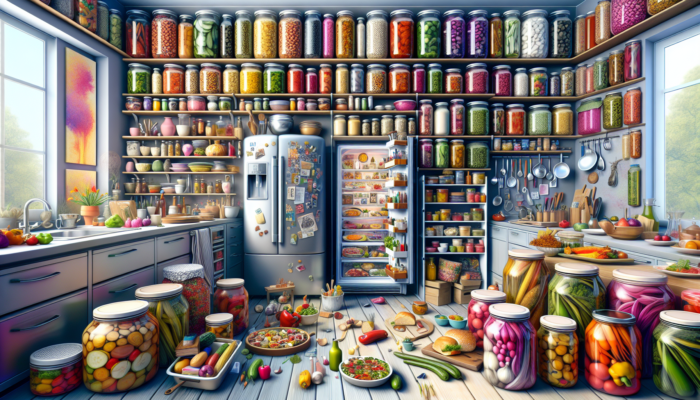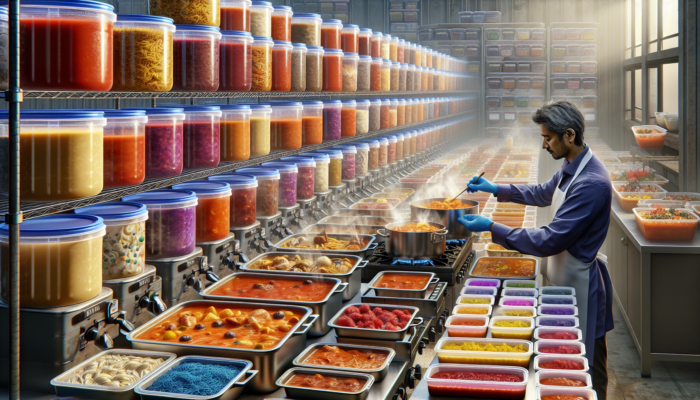Unlock the Secrets of Food Preservation for Optimal Freshness and Flavor
Mastering food preservation techniques has become a vital practice for anyone seeking culinary excellence and making environmentally friendly choices. By adopting these expert methods, you can enhance the vibrant flavors of your meals while also playing a significant role in reducing waste and preserving our planet. This approach guarantees that your greens stay crisp and your leftovers don’t devolve into unwanted science projects. Let’s explore the essential principles that underpin effective food preservation, starting with a comprehensive examination of the causes of spoilage and how to combat them.
Dive into the Science of Food Spoilage: Key Factors That Compromise Freshness

Spoilage is an unavoidable process that can affect even our most beloved foods; however, by understanding the intricate science behind spoilage, you can arm yourself with the knowledge needed to effectively counteract its effects. Three main factors are at play when it comes to the breakdown of food: microbial growth, enzymatic reactions, and oxidation. Microorganisms such as bacteria, yeasts, and molds thrive in nutrient-dense environments, making leftovers like pasta particularly prone to deterioration. Essentially, the more moisture and warmth present, the quicker spoilage will occur, leading to potential food waste.
Enzymatic reactions are another critical element in this discussion. Enzymes, which are natural catalysts, play a significant role in the ripening process of fruits and vegetables. However, once food reaches its peak ripeness, these enzymes can instigate a decline in quality and freshness. Additionally, oxidation refers to the chemical reaction that occurs when oxygen interacts with food components, often resulting in fat rancidity and the browning of fruits, which further compromises their appeal.
By grasping these foundational concepts regarding spoilage, you can take proactive steps to implement effective food preservation techniques that dramatically extend the shelf life of your ingredients. Every action you take, from controlling moisture levels to using airtight containers, plays a crucial role in enhancing the freshness and flavor of your food.
Optimal Temperature Settings for Food Preservation: Your Essential Guide to Refrigeration and Freezing
Temperature regulation is your most reliable partner in the ongoing fight against spoilage. Maintaining your refrigerator at a consistent temperature of about 4°C (39°F) is essential for effectively slowing down microbial growth. It’s a delicate balance; if the fridge is too warm, you may invite bacterial growth, while overly cold settings can freeze delicate herbs and other perishable items, rendering them unusable.
For your freezer, aim for temperatures of -18°C (0°F) or lower. This specific setting effectively halts microbial activity while preserving essential nutrients in your food. However, how you store food within these cold environments is equally important. Utilizing airtight containers or high-quality freezer bags is crucial to preventing freezer burn, which can significantly detract from the quality of your food in terms of both taste and texture. Be sure to label and date your frozen items, transforming your freezer into a well-organized culinary time capsule rather than a mysterious black hole.
By mastering temperature control, you’ll not only prolong the freshness of your food but also enhance the overall quality of your meals, making it easier to create delicious dishes any day of the week.
Humidity Management: Proven Techniques to Keep Your Produce Fresh and Crisp
Humidity is a crucial yet often overlooked element in the preservation of fruits and vegetables. The key is to find the perfect balance between excessive dryness and overwhelming moisture. High humidity can encourage mold growth, while low humidity levels can lead to desiccation, causing fresh carrots to transform into sad, shriveled sticks.
To effectively manage humidity in your refrigerator, utilize the crisper drawers, which are usually equipped with adjustable humidity settings. For leafy greens, wrap them in a damp paper towel to maintain moisture without creating a soggy environment that could foster spoilage. You might also consider investing in humidity-control packs or creating DIY solutions, such as placing a small bowl of water in your fridge to help stabilize moisture levels.
Furthermore, it’s wise to keep fruits separate from vegetables, as this minimizes exposure to ethylene gas, which can accelerate both ripening and spoilage. Fruits like apples, bananas, and avocados are notorious ethylene producers, so designating a specific area for them can help prevent unwanted spoilage across your produce.
By mastering humidity control, you’ll ensure that your fruits and vegetables remain vibrant and crisp, ready to add fresh flavors to your meals and snacks.
Smart Food Preservation Strategies for Busy Lifestyles: Convenient Solutions for Everyday Cooking

In our fast-paced world, time is often limited, and innovative food preservation strategies can bridge the gap between preparing a homemade meal and relying on last-minute takeout. Let’s explore some ingenious techniques tailored specifically for busy households, ensuring that you can always enjoy delicious, hassle-free meals.
Quick Pickling: A Simple and Flavorful Way to Preserve Your Vegetables
Quick pickling is an incredible culinary technique that can turn ordinary vegetables into zesty delights. This method involves immersing vegetables in a mixture of vinegar, water, salt, and sugar, allowing them to absorb flavor while extending their shelf life. The process is remarkably simple: just slice your vegetables, boil the pickling solution, and pour it over the veggies in a clean jar for an instant flavor boost.
Homemade pickles can be enjoyed within just one day and can last for weeks when stored in the refrigerator. Think cucumbers, carrots, or red onions—these flavorful additions are perfect for elevating salads, sandwiches, and charcuterie boards. This technique serves as a fantastic way to utilize any wilting vegetables before they end up in the compost bin.
Quick pickling not only adds a burst of flavor but also encourages culinary creativity. Feel free to experiment with various spices and herbs to customize your pickling solution, transforming your refrigerator into a treasure trove of tangy, delightful treats.
Freezer Meals: Streamlining Meal Preparation for Unmatched Convenience
Imagine coming home after a long day to find a delicious home-cooked meal waiting for you. Enter freezer meals, the ultimate time-saving strategy for busy households. By dedicating just a few hours to meal prep, you can batch-cook and freeze meals that are ready to heat up whenever hunger strikes.
Start by selecting recipes that freeze well, such as casseroles, soups, and stews. Cook in bulk, portion the meals into freezer-friendly containers, and label them with the date and contents for easy identification. When hunger calls, simply grab a meal from the freezer, pop it in the microwave or oven, and voilà—dinner is served!
This approach not only saves you precious time but also minimizes food waste—no more leftover ingredients languishing at the back of your refrigerator. Plus, you’ll find it easier to resist the temptation of takeout, knowing that a hearty, home-cooked meal is just minutes away.
Batch Cooking: Efficiently Preparing Large Quantities for Future Enjoyment

Batch cooking is the ultimate solution for meal prep, enabling you to prepare large quantities of food in a single session. This efficient and economical strategy ensures that you always have nutritious meals readily available when you need them.
Begin by selecting recipes that are well-suited for batch cooking—think hearty stews, pasta sauces, and stir-fries. Dedicate some time over the weekend to cook in bulk, portion your creations into airtight containers, and store them in the fridge or freezer for future use.
This method streamlines your weekday meal prep and helps you manage portion sizes, promoting healthier eating habits. Furthermore, it encourages culinary creativity—mix and match ingredients to keep your meals exciting, ensuring you never grow bored with the same offerings.
Batch cooking truly embodies the essence of food preservation techniques, transforming your kitchen into a haven of convenience and flavor.
Comprehensive Guide to Food Preservation: Embracing Natural Methods for Waste Reduction
As we navigate the complexities of modern living, embracing natural food preservation methods becomes an essential practice. With sustainability as our guiding principle, let’s delve into three powerful techniques designed to minimize waste while enhancing the flavors of our food.
Fermentation: Utilizing Beneficial Bacteria for Effective Food Preservation
Fermentation is a time-honored technique that not only preserves food but also enhances its nutritional profile. By leveraging the power of beneficial bacteria, you can create probiotic-rich foods that promote gut health while extending their shelf life.
The fermentation process begins with the introduction of beneficial bacteria to your food, often through a starter culture or naturally occurring microbes. Commonly fermented foods include sauerkraut, kimchi, and yogurt. The magic happens as these bacteria consume sugars and produce lactic acid, which creates an environment where harmful bacteria cannot thrive.
Fermentation is accessible and requires minimal ingredients and equipment. Simply chop your vegetables, mix them with salt, and allow them to ferment in a clean jar. The result? A tangy, flavorful product that can last for months in your refrigerator—delicious on its own or as a complement to various dishes.
Dehydration: An Effective Method for Preserving Fruits, Vegetables, and Herbs Naturally
Dehydration is a straightforward technique that preserves food while retaining its flavor and nutritional value. By removing moisture, you effectively hinder the growth of spoilage-causing microorganisms, allowing you to enjoy seasonal produce long after harvest.
You can dehydrate food using a dehydrator, an oven, or by air-drying herbs. Cut fruits and vegetables evenly to ensure consistent drying. When it comes to herbs, tie them in bunches and hang them in a warm, dry area. The outcome is concentrated flavors that can be used in cooking, snacking, or as flavorful garnishes.
Not only does dehydration extend shelf life, but it also significantly reduces food waste. Imagine transforming an abundance of apples into delightful dried chips or overripe tomatoes into sun-dried delicacies. The possibilities are virtually endless!
Canning: A Time-Tested Method for Long-Term Food Preservation
Canning is a traditional preservation method that has stood the test of time. This technique involves sealing food in airtight jars and heating them to eliminate the bacteria and enzymes that cause spoilage.
When canning fruits, vegetables, or sauces, it is crucial to adhere to proper safety protocols to prevent health risks. Invest in quality canners and jars, ensuring they are sterilized before use. The beauty of canning lies in its versatility; you can enjoy your garden's bounty year-round, transforming seasonal produce into delicious preserves.
From homemade jams to pickled vegetables, the satisfaction of opening a jar of your homemade creations during the colder months is unparalleled. Canning not only extends the shelf life of your food but also celebrates the joy of home cooking, allowing you to relish the flavors of the season long after they have passed.
Modern Food Preservation Techniques: Utilizing Technology and Gadgets for Better Storage
Modern innovations can revolutionize the way we preserve food in an age of rapid technological advancements. With cutting-edge gadgets at our disposal, let’s explore how technology enhances food preservation techniques in the contemporary kitchen.
Vacuum Sealing: Effortlessly Extend the Shelf Life of Your Food
Vacuum sealing is a remarkable method for food preservation. By removing air from bags or containers, you significantly reduce the risk of spoilage, keeping your food fresher for an extended period.
This technique is particularly effective for meats, cheeses, and dry goods. Simply place your food in a vacuum-sealable bag, use the vacuum sealer to extract the air, and seal it shut. The outcome is an airtight environment that inhibits bacterial growth and oxidation.
Vacuum-sealed food can remain fresh up to five times longer than traditionally stored items. Additionally, it’s incredibly versatile; you can use it for marinating meats, sous vide cooking, or storing bulk items. Embrace vacuum sealing to elevate your food storage practices to new heights.
Smart Refrigerators: Advanced Technology for Food Monitoring and Preservation
Welcome to the future of food preservation: smart refrigerators! These advanced appliances come equipped with features that enable you to monitor your food inventory, track expiration dates, and even suggest recipes based on what’s inside.
Imagine receiving notifications on your smartphone when your milk is about to expire or when it’s time to use that leftover roast. Smart refrigerators help minimize food waste and ensure you utilize your ingredients efficiently.
Some models even allow you to remotely control temperature and humidity settings, ensuring optimal conditions for preserving your food. With these innovations, your refrigerator becomes a proactive partner in your culinary adventures.
Sous Vide Cooking: A Precise Technique for Maintaining Food Quality
Sous vide cooking is a precise method that involves sealing food in vacuum-sealed bags and cooking it in a water bath at a controlled temperature. This technique not only preserves the quality of your ingredients but also locks in flavors while ensuring even cooking.
The sous vide method enhances the taste and texture of your meals, thereby prolonging their shelf life. Cooking in a vacuum-sealed environment minimizes exposure to air, reducing the risk of spoilage.
Sous vide is perfect for meal prep; you can cook and freeze large batches for future enjoyment. When you’re ready to eat, simply reheat your sous vide meal, and you’ll enjoy restaurant-quality dishes right at home.
Embracing sous vide cooking offers a culinary time machine, allowing you to preserve the quality of your meals while effortlessly enjoying gourmet flavors in your everyday cooking.
Essential Food Preservation Techniques for Eco-Conscious Consumers
As awareness of environmental issues continues to rise, sustainable practices in food preservation have become vital. Let’s explore practical strategies that minimize food waste while contributing to a healthier planet.
Strategies for Minimizing Food Waste: Key Practices for Reducing Your Environmental Impact
Minimizing food waste is a critical aspect of sustainable living. One of the most effective strategies is to plan your meals meticulously. Create a shopping list based on your needs and stick to it to avoid impulse purchases that might lead to waste.
Moreover, get creative with your leftovers. For example, transform yesterday’s roast into a hearty soup or use stale bread to make croutons. By embracing innovative cooking techniques, you’ll discover countless ways to utilize what you already have before it spoils.
Educating yourself about proper food storage methods is equally crucial. Understanding the best techniques for storing fruits, vegetables, and leftovers can greatly extend their shelf life and significantly reduce waste.
By implementing these strategies, you not only lessen your environmental footprint but also cultivate a more mindful approach to food consumption.
Composting: Transforming Food Scraps into Nutrient-Rich Soil for Your Garden
Composting is an excellent way to convert food scraps into nutritious soil, effectively closing the loop on food waste. By composting, organic waste is diverted from landfills, where it would otherwise contribute to harmful greenhouse gas emissions.
Start by establishing a compost bin in your garden or kitchen. Collect vegetable peels, coffee grounds, eggshells, and other organic materials. Layer them with browns, such as dried leaves and cardboard, to create a balanced compost mixture.
Over time, these scraps will decompose into rich, dark compost that can nourish your garden. Composting not only reduces waste but also enhances soil health, promoting healthy plant growth and minimizing the need for chemical fertilizers.
Embrace composting as a sustainable practice that benefits both your kitchen and your garden, creating a beautiful cycle of nourishment.
Upcycling: Innovative Ways to Repurpose Leftover Ingredients and Reduce Waste
Upcycling is the art of transforming leftover ingredients into something new and exciting. Instead of discarding those wilting greens or overripe bananas, unleash your creativity!
For instance, turn stale bread into breadcrumbs or croutons. Use vegetable scraps to create a flavorful broth or blend overripe fruits into refreshing smoothies. The possibilities are endless when you cultivate a mindset of creativity in the kitchen.
Moreover, consider incorporating this philosophy into your cooking routine. Plan meals that consciously use up ingredients nearing their expiration dates, ensuring nothing goes to waste while delighting your palate.
By prioritizing upcycling, you foster a sustainable kitchen that celebrates resourcefulness, creativity, and deliciousness.
Tailored Food Preservation Techniques for Specific Food Types: Customized Solutions for Your Kitchen
Every type of food has unique characteristics when it comes to preservation. Understanding these nuances can help you tailor your strategies for maximum effectiveness. Let’s explore how to preserve specific food types with targeted techniques.
Preserving Fresh Herbs: Effective Techniques to Maintain Flavor and Vibrancy
Fresh herbs can elevate any dish, but they often wilt before you can fully appreciate their potential. Consider several effective methods to preserve the vibrancy and flavor of your herbs.
One popular technique involves freezing herbs in olive oil. Chop your fresh herbs, mix them with olive oil, and pour the mixture into ice cube trays. Once frozen, transfer the cubes to a freezer bag for easy access. These flavor-packed cubes can be added directly to soups, stews, or sauces, infusing your dishes with fresh herb goodness.
Alternatively, you can dry herbs by hanging them upside down in a well-ventilated area. Once dried, store them in airtight jars to preserve their flavor for months.
By mastering the art of herb preservation, you’ll always have fresh flavors at your fingertips, enhancing your culinary creations with ease.
Extending the Shelf Life of Dairy Products: Practical Tips for Storing Milk, Cheese, and Yogurt
Dairy products can be tricky to preserve, but with a few simple hacks, you can significantly extend their shelf life. To maintain freshness, always store milk in the coldest section of your fridge, ideally at the back, where temperatures are most consistent.
Cheese benefits from being wrapped in parchment paper before being placed in an airtight container. This method allows it to breathe while preventing it from drying out. For soft cheeses, consider adding a small piece of wax paper to absorb excess moisture, keeping them in optimal condition.
Yogurt can also be effectively preserved by ensuring the lid is tightly sealed and storing it away from strong-smelling foods to maintain its delicate flavor profile.
Implementing these practical tips will ensure your dairy products remain fresh and enjoyable for longer, reducing waste and enhancing your meals.
Preserving Bread and Baked Goods: Techniques to Keep Your Favorite Treats Fresh and Delicious
Bread and baked goods can quickly turn stale, but using the right preservation techniques can help keep them fresh and delicious. To maintain its crusty exterior, store bread in a paper bag at room temperature for short-term storage.
For longer storage, freezing is your best option. Slice the loaf before freezing, so you can pull out individual slices as needed. Wrap the bread tightly in plastic or foil, then place it in a freezer bag. When you’re ready to enjoy, simply toast or thaw at room temperature for optimal taste.
Baked goods like cookies or cakes should be stored in an airtight container to retain moisture. If they are frosted, consider refrigerating them to prevent melting, ensuring they stay delicious.
By mastering these preservation techniques, you can savor your favorite baked treats without worrying about them going stale or losing their delightful flavors.
Common Questions About Food Preservation Techniques: Addressing Your Queries
What is the Safe Storage Duration for Different Types of Food?
The duration of safe storage varies by food type. Generally, most meats can be frozen for 6-12 months, while fruits and vegetables last around 8-12 months in the freezer. Always refer to specific guidelines for each type of food to ensure safety and quality.
What Are the Common Signs of Spoilage, and How Can I Prevent Foodborne Illness?
Common indicators of spoilage include off odors, changes in texture, and visible mold. To prevent foodborne illnesses, practice proper food storage, hygiene, and cooking techniques to keep your food safe and delicious.
Can I Combine Different Preservation Methods for Enhanced Results?
Absolutely! Combining preservation methods can improve outcomes. For instance, you can pickle vegetables and then vacuum seal them, extending their shelf life while adding exciting flavors.
How Can I Determine If My Canning Process Was Successful?
A sealed lid that doesn’t pop when pressed indicates a successful canning process. If the lid flexes, the jar may not be adequately sealed and should be refrigerated and consumed soon to avoid spoilage.
Is it Possible to Freeze Leftover Canned Food?
Yes, you can freeze leftover canned food. Just transfer the contents to an airtight container before freezing to prevent freezer burn and preserve quality.
What is the Best Method for Storing Leftover Takeaway Food?
Store leftover takeaway food in airtight containers in the refrigerator. For optimal food safety and quality, consume within 3-4 days.
Can I Preserve Cooked Food, and How Long Does It Last?
Yes, cooked food can be preserved by refrigerating or freezing it. In the fridge, it lasts 3-4 days; in the freezer, it can last 2-6 months, depending on the type of food.
Is It Safe to Consume Food Past Its Expiration Date?
Not all foods are unsafe after their expiration date has passed. Check for signs of spoilage; if they look and smell fine, they may still be safe to consume within a reasonable timeframe.
How Can I Tell If My Food Has Experienced Freezer Burn?
Freezer burn is characterized by dry, discolored patches on food. While the food remains safe to eat, the affected areas may have an unappealing taste and texture.
What Should I Do with Food That Has Spoiled?
Dispose of any spoiled food immediately to prevent contamination of other items. Composting is an eco-friendly option for organic waste, allowing you to give back to the earth.
Explore our world on X!
The post Food Preservation Techniques: Discover Revolutionary Hacks appeared first on Survival Bite.
The Article Food Preservation Techniques: Explore Innovative Hacks Was Found On https://limitsofstrategy.com

